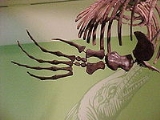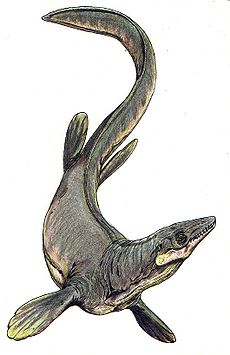
Plioplatecarpinae
Encyclopedia
Plioplatecarpinae is a subfamily of mosasaur
s, a diverse group of late Cretaceous
marine squamates.
Russell (1967, pp. 148) defined the Plioplatecarpinae as follows: Small rostrum
present or absent anterior to premaxilla
ry teeth. Cranial nerves X, XI, XII leave lateral wall of opisthotic through single foramen
. Canal or deep groove in floor of basioccipital and basispehnoid for basilar artery. Suprastapedial process of quadrate
large, bluntly terminated and with parallel sides. Dorsal edge of surangular rounded and longitudinally horizontal...Twenty-nine or less presacral vertebrae present. Length of presacral series less than that of postsacral, neural spines of posterior caudal vertebrae at most only slightly elongated, do not form an appreciable fin. Haemal arch
es usually unfused to caudal centra
. Appendicular elements lack smoothly finished articular surfaces."
Genera
referrable to the Plioplatecarpinae (informally and collectively known as "plioplatecarpines") have been found on all continents, though the occurrences in Australia remain questionable. The etymology
of the subfamily is derived from one of its members, Plioplatecarpus: Greek
pleion = "more" + Greek
plate = "oar" + Greek
karpos = "wrist, carpus
"). In general, plioplatecarpines were short-skulled, short-bodied forms and were among the strongest swimming mosasaurs . Some workers have likened them to pinniped
s in their agility . Most forms were likely piscivores ("fish eaters"), though cephalopod
s (belemnites) evidently formed an important part of the plioplatecarpine diet. Larger forms may have also fed upon smaller marine reptiles. At least one genus
evolved sturdy crushing teeth adapted to feeding on shellfish
. The plioplatecarpines were medium-sized mosasaurs ranging from 12-25 feet in length. Russell included two tribes, the Plioplatecarpini and Prognathodontini, the latter of which has been reassigned by Bell to the Mosasaurinae
.
Polcyn and Bell (2005, p. 322 ) have erected a more inclusive clade, the parafamily Russellosaurina, which includes the "subfamilies Tylosaurinae
and Plioplatecarpini and their sister-clade containing the genera Tethysaurus, Russellosaurus
, and Yaguarasaurus."
The first plioplatecarpines appear in the Turonian
and are among the oldest of mosasaurs, and the clade persists throughout the Maastrichtian
, a period of approximately 24 million years.

Mosasaur
Mosasaurs are large extinct marine lizards. The first fossil remains were discovered in a limestone quarry at Maastricht on the Meuse in 1764...
s, a diverse group of late Cretaceous
Cretaceous
The Cretaceous , derived from the Latin "creta" , usually abbreviated K for its German translation Kreide , is a geologic period and system from circa to million years ago. In the geologic timescale, the Cretaceous follows the Jurassic period and is followed by the Paleogene period of the...
marine squamates.
Russell (1967, pp. 148) defined the Plioplatecarpinae as follows: Small rostrum
Rostrum (anatomy)
The term rostrum is used for a number of unrelated structures in different groups of animals:*In crustaceans, the rostrum is the forward extension of the carapace in front of the eyes....
present or absent anterior to premaxilla
Premaxilla
The incisive bone is the portion of the maxilla adjacent to the incisors. It is a pair of small cranial bones at the very tip of the jaws of many animals, usually bearing teeth, but not always. They are connected to the maxilla and the nasals....
ry teeth. Cranial nerves X, XI, XII leave lateral wall of opisthotic through single foramen
Foramen
In anatomy, a foramen is any opening. Foramina inside the body of humans and other animals typically allow muscles, nerves, arteries, veins, or other structures to connect one part of the body with another.-Skull:...
. Canal or deep groove in floor of basioccipital and basispehnoid for basilar artery. Suprastapedial process of quadrate
Quadrate bone
The quadrate bone is part of a skull in most tetrapods, including amphibians, sauropsids , and early synapsids. In these animals it connects to the quadratojugal and squamosal in the skull, and forms part of the jaw joint .- Evolutionary variation :In snakes, the quadrate bone has become elongated...
large, bluntly terminated and with parallel sides. Dorsal edge of surangular rounded and longitudinally horizontal...Twenty-nine or less presacral vertebrae present. Length of presacral series less than that of postsacral, neural spines of posterior caudal vertebrae at most only slightly elongated, do not form an appreciable fin. Haemal arch
Haemal arch
A haemal arch is a bony arch on the underside of a tail vertebra of a vertebrate.The hole so formed is the haemal canal.It sometimes has a haemal spine on.The blood vessels to and from the tail run through the arch....
es usually unfused to caudal centra
Centra
Centra is a convenience store chain in Ireland.The chain is run by Musgrave, the Irish food wholesaler, however the stores are all owned by individual franchisees. The chain has three different formats available to franchisees — smaller Quick Stop outlets, mid-sized Foodmarkets, and larger...
. Appendicular elements lack smoothly finished articular surfaces."
Genera
Genus
In biology, a genus is a low-level taxonomic rank used in the biological classification of living and fossil organisms, which is an example of definition by genus and differentia...
referrable to the Plioplatecarpinae (informally and collectively known as "plioplatecarpines") have been found on all continents, though the occurrences in Australia remain questionable. The etymology
Etymology
Etymology is the study of the history of words, their origins, and how their form and meaning have changed over time.For languages with a long written history, etymologists make use of texts in these languages and texts about the languages to gather knowledge about how words were used during...
of the subfamily is derived from one of its members, Plioplatecarpus: Greek
Greek language
Greek is an independent branch of the Indo-European family of languages. Native to the southern Balkans, it has the longest documented history of any Indo-European language, spanning 34 centuries of written records. Its writing system has been the Greek alphabet for the majority of its history;...
pleion = "more" + Greek
Greek language
Greek is an independent branch of the Indo-European family of languages. Native to the southern Balkans, it has the longest documented history of any Indo-European language, spanning 34 centuries of written records. Its writing system has been the Greek alphabet for the majority of its history;...
plate = "oar" + Greek
Greek language
Greek is an independent branch of the Indo-European family of languages. Native to the southern Balkans, it has the longest documented history of any Indo-European language, spanning 34 centuries of written records. Its writing system has been the Greek alphabet for the majority of its history;...
karpos = "wrist, carpus
Carpus
In tetrapods, the carpus is the sole cluster of bones in the wrist between the radius and ulna and the metacarpus. The bones of the carpus do not belong to individual fingers , whereas those of the metacarpus do. The corresponding part of the foot is the tarsus...
"). In general, plioplatecarpines were short-skulled, short-bodied forms and were among the strongest swimming mosasaurs . Some workers have likened them to pinniped
Pinniped
Pinnipeds or fin-footed mammals are a widely distributed and diverse group of semiaquatic marine mammals comprising the families Odobenidae , Otariidae , and Phocidae .-Overview: Pinnipeds are typically sleek-bodied and barrel-shaped...
s in their agility . Most forms were likely piscivores ("fish eaters"), though cephalopod
Cephalopod
A cephalopod is any member of the molluscan class Cephalopoda . These exclusively marine animals are characterized by bilateral body symmetry, a prominent head, and a set of arms or tentacles modified from the primitive molluscan foot...
s (belemnites) evidently formed an important part of the plioplatecarpine diet. Larger forms may have also fed upon smaller marine reptiles. At least one genus
Genus
In biology, a genus is a low-level taxonomic rank used in the biological classification of living and fossil organisms, which is an example of definition by genus and differentia...
evolved sturdy crushing teeth adapted to feeding on shellfish
Shellfish
Shellfish is a culinary and fisheries term for exoskeleton-bearing aquatic invertebrates used as food, including various species of molluscs, crustaceans, and echinoderms. Although most kinds of shellfish are harvested from saltwater environments, some kinds are found only in freshwater...
. The plioplatecarpines were medium-sized mosasaurs ranging from 12-25 feet in length. Russell included two tribes, the Plioplatecarpini and Prognathodontini, the latter of which has been reassigned by Bell to the Mosasaurinae
Mosasaurinae
Mosasaurinae is a subfamily of mosasaurs, a diverse group of Late Cretaceous marine squamates.Russell defined the Mosasurinae as differing from all other mosasaurs as follows: "Small rostrum present or absent anterior to premaxillary teeth. Fourteen or more teeth present in dentary and maxilla...
.
Polcyn and Bell (2005, p. 322 ) have erected a more inclusive clade, the parafamily Russellosaurina, which includes the "subfamilies Tylosaurinae
Tylosaurinae
Tylosaurinae is a subfamily of mosasaurs, a diverse group of Late Cretaceous marine lizards.Russell defined the Tylosaurinae as follows: "Large rostrum present anterior to premaxillary teeth. Twelve or more teeth in dentary and maxilla. Cranial nerves X, XI, and XII leave lateral wall of...
and Plioplatecarpini and their sister-clade containing the genera Tethysaurus, Russellosaurus
Russellosaurus
Russellosaurus is a basal mosasauroid from the Upper Cretaceous of North America. The genus was described from a skull discovered in an exposure of the Arcadia Park Shale at Cedar Hill, Dallas County in south-central Texas...
, and Yaguarasaurus."
The first plioplatecarpines appear in the Turonian
Turonian
The Turonian is, in the ICS' geologic timescale, the second age in the Late Cretaceous epoch, or a stage in the Upper Cretaceous series. It spans the time between 93.5 ± 0.8 Ma and 89.3 ± 1 Ma...
and are among the oldest of mosasaurs, and the clade persists throughout the Maastrichtian
Maastrichtian
The Maastrichtian is, in the ICS' geologic timescale, the latest age or upper stage of the Late Cretaceous epoch or Upper Cretaceous series, the Cretaceous period or system, and of the Mesozoic era or erathem. It spanned from 70.6 ± 0.6 Ma to 65.5 ± 0.3 Ma...
, a period of approximately 24 million years.
Species and Taxonomy

- Plioplatecarpinae
- Plioplatecarpini
- PlatecarpusPlatecarpusPlatecarpus is an extinct genus of aquatic lizard belonging to the mosasaur family, living around 75 million years ago during the end of the Cretaceous period. Fossils have been found in Belgium and the United States as well as a possible specimen in Africa. Platecarpus probably fed on fish,...
(paraphyletic)- P. tympaniticus (=P. coryphaeus, P. ictericus )
- P. planifrons
- P. bocagei (=Angolasaurus )
- EctenosaurusEctenosaurusEctenosaurus is a genus of mosasaur from the Late Cretaceous period....
- E. clidastoides
- SelmasaurusSelmasaurusSelmasaurus is a genus of medium-sized plioplatecarpine mosasaur from the Upper Cretaceous Mooreville Chalk Formation of western Alabama...
- S. russelli
- IgdamanosaurusIgdamanosaurusIgdamanosaurus is a genus of mosasaur from the Maastrichtian stage of the Late Cretaceous of Africa.-References:* Fossil Vertebrates - Fauna and Concepts by W. Sargeant and William A.S. Sargeant...
- I. aegyptiacus
- YaguarasaurusYaguarasaurusYaguarasaurus was a genus of mosasaur from the Late Cretaceous period of Colombia, South America. The remains discovered were defined as a new genus and species of the tribe Plioplatecarpini, Yaguarasaurus columbianus, by the Colombian paleontologist María Páramo, former director of the Museo de...
- Y. colombianus
- PlioplatecarpusPlioplatecarpusPlioplatecarpus is a genus of mosasaur lizard. Like all mosasaurs, it lived in the late Cretaceous period, about 83.5 million years ago.-Description:...
- P. primaevus
- P. houzeaui
- P. marshii
- P. nichollsae
- Platecarpus
- Plioplatecarpini

